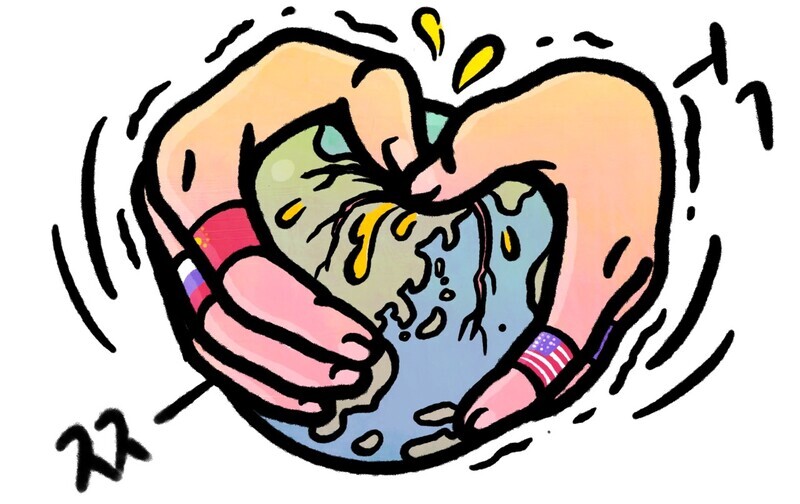hankyoreh
Links to other country sites 다른 나라 사이트 링크
[Column] Return of the Cold War, or something older?


By Pak Noja (Vladimir Tikhonov), professor of Korean Studies at the University of Oslo
You hear a lot of talk these days of a “new Cold War.”
What we are seeing is a new battle for hegemony among the same countries that were major participants in the (old) Cold War — the US, China, and Russia — which makes it easy to conceptualize it as a “return of the Cold War.”
But the term “new Cold War” is actually sorely misleading. The previous Cold War was more or less a continuation of the Russian Revolution that occurred in 1917 and the Chinese Revolution that took place in 1949.
At least in principle, the countries on the opposite pole from the US and West were pursuing an “alternative modernity” distinct from classical capitalism. Moreover, they sought to achieve self-sufficiency as much as possible, maintaining some distance from the global capitalist system centering on Europe and America.
Yet China today is a country where foreign trade accounts for a larger percentage of its gross domestic product (GDP) — 37% — than in the US, where the number is 24%. As severe as the Chinese media’s anti-US agitation might get, the US is still China’s top overseas market, purchasing no less than 17% of its exports.
A one-party state like China is obviously different from the US’ version of two-party democracy by corporations and for corporations. Yet their differences do not extend beyond the shared bounds of capitalism.
Given that situation, it may be more accurate to view this situation not as a return to the Cold War, but as a return to the fin-de-siecle years from 1870 to 1914 — in other words, to the golden age of classical imperialism.
If our current era is one of faltering US hegemony, the years from 1870 to 1914 constituted an era in which British dominance over the world came to an end. Already in 1910, Germany, a challenger of the status quo, surpassed the UK, a hegemon, in terms of GDP. Currently, China — the challenger country — is projected to surpass the US — the hegemon — in nominal GDP around the year 2030.
Something to note, though, is that just like modern-day China and the US, the UK and Germany right before World War I had intimate ties when it came to trade and investments. Just like 17% of China’s exports today go to the US, 17% of the German Empire’s exports in 1910 went to Australia, South Africa, Canada, and other territories of the British Empire.
As if foreshadowing the growth trajectory of modern-day China, the German Empire pre-1914 developed into a bureaucracy much more powerful than the hegemonic country at the time, the British Empire. The share of public servants among the entire working population of the German Empire at the time was 4%, twice that of the British Empire.
Just as state-run companies dominate China’s strategic sectors today, the German Empire before 1914 owned and operated many of its domestic railway and banking companies, unlike the British Empire. Germany at the time proactively utilized state capitalism as a latecomer trying to catch up with a forerunner in terms of development, which has been the case for China today as well.
The more a hegemonic country is destabilized, the more heated competition and contests for colonial dominance amongst powerful nations become. Just like China of today, Germany of the past turned its eyes toward Africa, as it needed a “resource zone” as a latecomer trying to catch up with countries more developed than itself. One difference is that, unlike Germany, which gained colony after colony — such as Togo, Burundi, Cameroon and Namibia — in Africa pre-1914, China today has been focusing on advancing investment and trade relations with African countries.
Meanwhile, modern-day conflicts amongst powerful nations over peripheral territories sometimes result in horrifying bloodshed the likes of conflicts among colonial powers that took place during the early 20th century. Didn’t Japan and Russia wage an imperialist war from 1904 to 1905, in which over 100,000 died, in order to decide who would be the master of Manchuria and Joseon? In the war between Russia and Ukraine, which will decide whether Ukraine will become Russia’s political and economic colony or the economic colony of the European Union, 60,000 to 70,000 soldiers and civilians have already died, with casualties expected to continue to increase.
An age of war is always an age of nationalism. Marxists of the early 20th century called the modern nation state a “product of capitalism” and condemned nationalism as a “bourgeois ideology.” Scholars of today also consider the nation state an “imagined community” that came about after modernity. No more than an object of critical analysis in academia, however, nationalism is now running more and more rampant on the streets.
If yellow journalism served as the main disseminator of nationalism early in the 20th century, today, social media platforms that cannot possibly refuse direction and supervision from the state serve that very function. In Russia, where people are blocked from accessing US social media platforms like Facebook and can only use domestic social media platforms subject to government control like VKontakte, 73% of the citizenry consider the US an enemy, while in the US, 70% to 75% of the citizenry are also hostile toward Russia.
Similarly in China, where Western social media platforms are out of bounds, 60% to 70% of people hold unfavorable views of Japan. Of course, Japan doesn’t see China any more favorably either. Hate based on nationalism and exclusionism accompanies globalization and the intensification of imperialistic competition in the early 21st century just as it did at the beginning of the 20th century.
Like this, many factors at play in the world today are reminiscent of the world before 1914, but there are big differences between the two time periods as well. The most noteworthy one may be how “war” is being carried out then and now. Before 1914, while the hegemonic country of the British Empire didn’t have a draft during peacetime, major nations around the world commanded large conscript troops at all times. In that world, a “man” was inevitably a “soldier” as well.
Such a hard-line conscription system can no longer be found in most major nations around the world, only remaining in some buffer zones squished between powerful nations, like the Korean Peninsula. For instance, aside from Taiwan, another potential battlefield, there are no countries near the Korean Peninsula with a conscription system only. Russia already operates a mixed military composed of conscripts and volunteer troops, and most of its forces mobilized for the invasion of Ukraine volunteer soldiers.
As full-scale war amongst powerful nations is impossible or unlikely in the age of nuclear weapons, military conflict amongst powerful nations will mainly play out as proxy wars involving invasions and wars of aggression against buffer zones like Ukraine today. Devoting preliminary diplomatic efforts so that the Korean Peninsula does not become a site of such a war should be South Korea’s core policy task.
Faced with a complex geopolitical, economic and ecological crisis in which war, hatred of the “other,” and nationalism as well as exclusionism collide, the public will soon reach its limit in terms of patience, which will cause society to collapse internally. If spontaneous revolts like the Yellow Vest protests in France from several years ago recur, it will be interesting to see how much the progressive political forces would be able to use the momentum to radically shirk off neoliberalism, rebuild the welfare state, and build a new economy optimized to respond to the climate crisis.
Please direct questions or comments to [english@hani.co.kr]

Editorial・opinion
![[Column] Season 2 of special prosecutor probe may be coming to Korea soon [Column] Season 2 of special prosecutor probe may be coming to Korea soon](https://flexible.img.hani.co.kr/flexible/normal/500/300/imgdb/original/2024/0426/3317141030699447.jpg) [Column] Season 2 of special prosecutor probe may be coming to Korea soon
[Column] Season 2 of special prosecutor probe may be coming to Korea soon![[Column] Park Geun-hye déjà vu in Yoon Suk-yeol [Column] Park Geun-hye déjà vu in Yoon Suk-yeol](https://flexible.img.hani.co.kr/flexible/normal/500/300/imgdb/original/2024/0424/651713945113788.jpg) [Column] Park Geun-hye déjà vu in Yoon Suk-yeol
[Column] Park Geun-hye déjà vu in Yoon Suk-yeol- [Editorial] New weight of N. Korea’s nuclear threats makes dialogue all the more urgent
- [Guest essay] The real reason Korea’s new right wants to dub Rhee a founding father
- [Column] ‘Choson’: Is it time we start referring to N. Korea in its own terms?
- [Editorial] Japan’s rewriting of history with Korea has gone too far
- [Column] The president’s questionable capacity for dialogue
- [Column] Are chaebol firms just pizza pies for families to divvy up as they please?
- [Column] Has Korea, too, crossed the Rubicon on China?
- [Correspondent’s column] In Japan’s alliance with US, echoes of its past alliances with UK
Most viewed articles
- 1After election rout, Yoon’s left with 3 choices for dealing with the opposition
- 2Why Kim Jong-un is scrapping the term ‘Day of the Sun’ and toning down fanfare for predecessors
- 3Two factors that’ll decide if Korea’s economy keeps on its upward trend
- 4Noting shared ‘values,’ Korea hints at passport-free travel with Japan
- 5AI is catching up with humans at a ‘shocking’ rate
- 646% of cases of violence against women in Korea perpetrated by intimate partner, study finds
- 7Why Korea shouldn’t welcome Japan’s newly beefed up defense cooperation with US
- 8‘We must say no’: Seoul defense chief on Korean, USFK involvement in hypothetical Taiwan crisis
- 9[Column] Season 2 of special prosecutor probe may be coming to Korea soon
- 10Fast Food Workers’ Day comes to South Korea